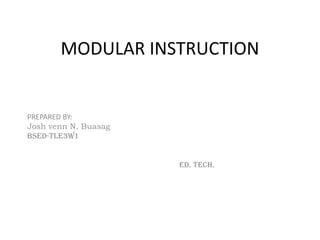
Modular instruction
- 1. MODULAR INSTRUCTION PREPARED BY: Josh venn N. Buasag bsed-tle3w1 ed. Tech.
- 2. ABSTRACT • The principles and purpose of modular instruction, its advantage for both students and instructors, and a comparison between the conventional and modular approach are presented.
- 3. • Separate sections deal with implementation and management of MI and include a discussion of evaluation and cost. Several examples of modular formats in use at North America universities are described.
- 4. • Present evidence suggests that MI meets the needs of today’s students more adequately than tradition instruction both with respect to the quality of learning and the content. However, certain problems may arise in implementing MI. These are presented from the perspective of the student, instructor, and administrator.
- 5. • Give its emphasis on individualized learning and its adaptability to large numbers of students, MI has emerged as one of the most promising alternatives in higher education today.
- 6. INTRODUCTION • In recent years, there has been an increasing focus on individualized instruction in higher education. On one hand, this may be viewed as a reaction to crowded classrooms and large classes which foster anonymity in teaching and learning. On the other, many studies have recently re-emphasized what teachers have known all along: There are great differences in how each student learns.
- 7. • Thus, there emerges the need for instructional systems which can make higher education available to large numbers of students and, at the same time, offer an individualized learning experience.
- 8. • Among the various systems of individualized instruction proposed so far, modular instruction is one of the newest and combines many advantages of a number of separate instructional innovations, such as performance objectives, self-pacing, and frequent feedback.
- 9. • A number of colleges and universities have successfully implemented modular courses and increasing interest in this approach is developing on many campuses. For this reason the present paper has been prepared. Its purpose is to review the principles, implementation, management, formats, problems, and research in modular instruction.
- 10. PRINCIPLES • WHAT IS A MODULE? For the purpose of the present discussion a module is defined as: 1.A Self-contained, independent unit of a planned series of learning activities designed to help the student accomplish certain well- defined objectives.
- 11. • 2.While differences in definition exist, it seems to be generally agreed that a modules is a curriculum package intended for self- study.
- 12. • WHAT IS MODULAR INSTRUCTION? • Modular instruction may be defined as instruction which is either partly or entirely based on modules. Current uses of modules range from one or a few modules inserted into a traditional course, through complete course that consist of a prescribed sequence of modules, to courses that offer the student the choice of a certain number of modules among a large set of modules.
- 13. • WHAT IS THE PURPOSE OF MODULAR INSTRUCTIONS? • One purpose of MI is to allow the student to proceed at his own rate. The belief that self- pacing is desirable is base on the generally accepted assumptions that learners do not achieve at the same rate and are not ready to learn at the same time.
- 14. • Another purpose is to allow the student to choose his own learning mode. Choice among different learning modes is desirable, if we assume that learners solve problems and learn using different techniques based on unique behavior repertoires.
- 15. THE END! THANK YOU
